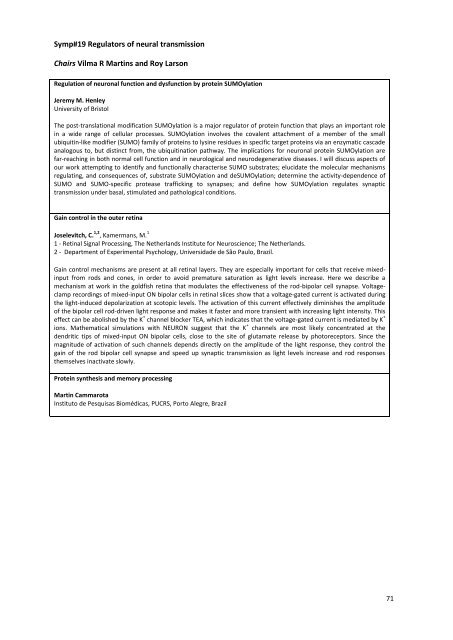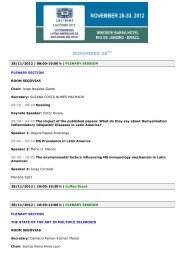Keynote Conference - Interevent
Keynote Conference - Interevent
Keynote Conference - Interevent
Create successful ePaper yourself
Turn your PDF publications into a flip-book with our unique Google optimized e-Paper software.
Symp#19 Regulators of neural transmission<br />
Chairs Vilma R Martins and Roy Larson<br />
Regulation of neuronal function and dysfunction by protein SUMOylation<br />
Jeremy M. Henley<br />
University of Bristol<br />
The post-translational modification SUMOylation is a major regulator of protein function that plays an important role<br />
in a wide range of cellular processes. SUMOylation involves the covalent attachment of a member of the small<br />
ubiquitin-like modifier (SUMO) family of proteins to lysine residues in specific target proteins via an enzymatic cascade<br />
analogous to, but distinct from, the ubiquitination pathway. The implications for neuronal protein SUMOylation are<br />
far-reaching in both normal cell function and in neurological and neurodegenerative diseases. I will discuss aspects of<br />
our work attempting to identify and functionally characterise SUMO substrates; elucidate the molecular mechanisms<br />
regulating, and consequences of, substrate SUMOylation and deSUMOylation; determine the activity-dependence of<br />
SUMO and SUMO-specific protease trafficking to synapses; and define how SUMOylation regulates synaptic<br />
transmission under basal, stimulated and pathological conditions.<br />
Gain control in the outer retina<br />
Joselevitch, C. 1,2 , Kamermans, M. 1<br />
1 - Retinal Signal Processing, The Netherlands Institute for Neuroscience; The Netherlands.<br />
2 - Department of Experimental Psychology, Universidade de São Paulo, Brazil.<br />
Gain control mechanisms are present at all retinal layers. They are especially important for cells that receive mixedinput<br />
from rods and cones, in order to avoid premature saturation as light levels increase. Here we describe a<br />
mechanism at work in the goldfish retina that modulates the effectiveness of the rod-bipolar cell synapse. Voltageclamp<br />
recordings of mixed-input ON bipolar cells in retinal slices show that a voltage-gated current is activated during<br />
the light-induced depolarization at scotopic levels. The activation of this current effectively diminishes the amplitude<br />
of the bipolar cell rod-driven light response and makes it faster and more transient with increasing light intensity. This<br />
effect can be abolished by the K + channel blocker TEA, which indicates that the voltage-gated current is mediated by K +<br />
ions. Mathematical simulations with NEURON suggest that the K + channels are most likely concentrated at the<br />
dendritic tips of mixed-input ON bipolar cells, close to the site of glutamate release by photoreceptors. Since the<br />
magnitude of activation of such channels depends directly on the amplitude of the light response, they control the<br />
gain of the rod bipolar cell synapse and speed up synaptic transmission as light levels increase and rod responses<br />
themselves inactivate slowly.<br />
Protein synthesis and memory processing<br />
Martin Cammarota<br />
Instituto de Pesquisas Biomédicas, PUCRS, Porto Alegre, Brazil<br />
71





